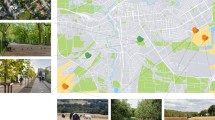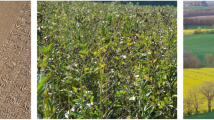Abstract
Cultivation of arabica coffee was implemented on the land of indigenous people outside the national park under an agroforestry program at Kerinci Seblat National Park (KSNP) in Indonesia aiming to reduce illegal activities inside the park. Traditional cropping patterns had increased the demand for land. This repetitive activity brought indigenous people to the national park for farming. We examine the economic impacts of the arabica coffee plantation program on the income of indigenous people and the changes in local activities in the national park through interpretation of maps, imagery/aerial photography, field surveys, and interviews with 244 households. Two surveys were conducted in 2016 (before the program), and in 2021 (after the program). We discovered that the average household income of the participating farmers increased by 109% after the program, while non-participating farmers saw a comparatively lower income increase of 91%. Moreover, program participants displayed a significant reduction of 83% in their activities within the parks. Conversely, a substantial 84% of households that did not participate in the program continued engaging in persistent, regular, and intensive activities within the national park.The program's achievements can be attributed to four primary factors: (1) effective coordination among multiple stakeholders, (2) the dedication and sacrifices made by traditional leaders and their families who served as program pioneers, (3) the commitment and diligence of field extension workers and farmers in practising sustainable agriculture for the cultivation of Arabica coffee, and (4) the cooperative's successful implementation of export-standard coffee bean processing and establishment of a robust market network.







Similar content being viewed by others
Data Availability
Data of this research will be available from the corresponding author on reasonable request.
Notes
In Africa, the main causes are the opening of new land by farmers due to population increase, and in Latin America are due to settlements, infrastructure projects, and land clearing for livestock and agriculture.
Indigenous people are local communities who have migrated from their original villages into enclave areas, where they represent the original Kerinci ethnic group that had already inhabited the enclave region prior to its designation as a production forest and national park area surrounding the enclave.
Tanah Tumbuh is a region located in the Muaro Bungo Regency, Jambi Province. In the eighteenth century, it served as one of the nearest trading centers to Kerinci.
References
Atmadja, S., Martius, C., Leonard, S., Sanz Sanchez, M. J. (2021). Transformational change to reduce deforestation and climate change impacts – A review of definitions, concepts and drivers in scientific and grey literature. Rome: Food and Agriculture Organization of the United Nations (FAO). https://doi.org/10.4060/cb7314en
Bass, S. (2001). The importance of social values. In J. Evans (Ed.), The forest Handbook (Vol. 1, pp. 362–371). Blackwel Science.
Cisneros, E., Börner, J., & Pagiola, S. (2021). Impacts of conservation incentives in protected areas: The case of Bolsa Floresta, Brazil. Journal of Environmental Economics and Management, 111(2022), 102572. https://doi.org/10.1016/j.jeem.2021.102572
Corlett, R. T., & Primack, R. B. (2008). Tropical Rainforest Conservation: A Global per- spective. In W. Carlson & S. Schnitzer (Eds.), Tropical Forest Community Ecology (pp. 442–457). Wiley-Blackwel.
da Costa Graciana, B., Ambarawati, I. G. A. A., Darmawan, D. P., & Budiasa, I. W. (2019). The Nucleus-Estate and Smallholder Partnership towards Ex- port Competitiveness of Timor Leste Coffee. Modern Economy, 10, 1655–1670. https://doi.org/10.4236/me.2019.107108
Eden, M. J. (1998). Forest and Environmental degradation. In Glodsmith, F. B(eds), Tropical rain forest: A wider perfective (pp. 99–117) Chapman & Hall.
Fujisawa, N., Tanaka, M., & Inoue, M. (2012). Flexibility of coffee agroforestry with diversified shade tree composition: A case study in Panama. Tropics, 21(2), 33–46. https://doi.org/10.3759/tropics.21.33
Ghazoul, J., & Evans, J. (2004). Couses of deforestation and forest fragmentation. In In Burley, J. Evans, J. Youngquist, J (eds). A, Encyclopedia of Forest Sciences (pp. 372–391). Oxford: Wiley-Blackwel.
Global Forest Watch. (2021). Forest monitoring designed for action. Retrieved January 6, 2023, from https://www.globalforestwatch.org/dashboards/country/IDN
Harada, K., & Wiyono. (2021). Case studies on fair trade coffee in North Sumatra and Aceh, Indonesia. In M. Inoue, K. Harada, Y. Yokata, & A. J. Muhammed (Eds.), Participatory forest management in a new age (pp. 185–211). University of Tokyo Press.
Harada, K., Ichihara, J., Aliadi, A., Probowo, D., & Hwan-ok, M. (2021). REDD+ national policy in Indonesia and case study on a REDD+ project in East Java. In M. Inoue, K. Harada, Y. Yokata, & A. J. Muhammed (Eds.), Participatory forest management in a new age (pp. 267–299). University of Tokyo Press.
Harada, K., Habib, M., Sakata, Y., & Maryudi, A. (2022a). The role of NGOs in recognition and sustainable maintenance of customary forest within indigenous people community: The case of Kerinci Indonesia. Land Use Policy, 113(2022), 105865. https://doi.org/10.1016/j.landusepol.2022.105865
Harada, K., Wiyono, & Munthe, L. (2022b). Production and commercialization of benzoin resin: Exploring the value of benzoin resin for local livelihoods in North Sumatra, Indonesia. Trees, Forests, and People, 7(2022), 100174. https://doi.org/10.1016/j.tfp.2021.100174
Harbi, J., Erbaugh, J. T., Sidiq, M., Haasler, B., & Nurraochmat, D. R. (2018). Making a bridge livelihoods and conservation: Lesson from non-timber forest product utilization in South Sumatera, Indonesia. Forest Policy and Economics, 94, 1–10. https://doi.org/10.1016/j.forpol.2018.05.011
Jha, S., Bacon, M., Philpott, S. M., Méndez, V. E., Läderach, P., & Rice, R. A. (2014). Shade coffee: Update on a disappearing refuge for biodiversity. BioScience, 64(5), 416–428. https://doi.org/10.1093/biosci/biu038
Kijazi, M. H., & Kant, S. (2010). Forest stakeholders’ value preferences in Mount Kilimanjaro. Tanzania. Forest Policy and Economics, 12(5), 357–369. https://doi.org/10.1016/j.forpol.2010.02.007
Krishnan, S. (2017). Sustainable Coffee Production. Advance online publication. https://doi.org/10.1093/acrefore/9780199389414.013.224
Lewin, B., Giovannucci, D., & Varangis, P. (2004). Coffee market: New paradigms in global supply and demand. Agriculture and Rural Development Discussion Paper 3. Washington, DC: World Bank, Agriculture and Rural Development Department. https://doi.org/10.2139/ssrn.996111
Marcus, R. R. (2001). Seeing the Forest for the Trees: Integrated Conservation and Development Projects and Local Perceptions of Conservation in Madagascar. Human Ecology, 29(4), 381–397. http://www.jstor.org/stable/4603408
Martius, C., Leonard, S., Barletti, J. P. S., & Prabbu, H. D. R. (2021). Forest, agricultural, ecosystem and nature for climate change mitigation and adaption. CIFOR-ICRAF. https://doi.org/10.17528/cifor/008267
Maryudi, A., Devkota, R., Schusser, C., Yufani, C., Salla, M., Aurenhammer, H., Uthaiwan, W., & Krott, M. (2012). Back to basics: Considerations in evaluating the outcomes of community forestry. Forest Policy and Economics, 14, 1–5. https://doi.org/10.1016/j.forpol.2011.07.017
Mukul, S. A., Rashid, A. Z. M. M., Quazi, S. A., Uddin, M. B., & Fox, J. (2012). Local Peoples responses to co-management regime in protect areas: A case study from Satchari National Park, Bangladesh. Forests, Trees and Livelihoods, 21(1), 16–29. https://doi.org/10.1080/14728028.2012.669132
Newton, P., Miller, D. C., Byankya, M. A. A., & Agrawal, A. (2016). Who are forest-dependent people? A taxonomy to aid livelihood and land use decision-making in forested regions. Land Use Policy, 57, 388–395. https://doi.org/10.1016/j.landusepol.2016.05.032
Nurrochmat, D. R., Nugroho, I. A., & Hardjanto.,Purwadianto., Maryudi, A., Erbaugh, J. T. (2017). Shifting contestation into cooperation: Strategy to intercorporate different interest of actors in medicinal plants in Meru Betiri National Parks, Indonesia. Forest Policy and Economics, 83, 162–168. https://doi.org/10.1016/j.forpol.2017.08.005
Purwanto, E. (2016). Strategi Anti-Perambahan di Tropical Rainforest Heritage of Sumatra Menuju Paradigma Baru (Anti-Encroachment Strategy in Tropical Rainforest Heritage of Sumatra Towards a New Paradigm), Jogjakarta; UNESCO dan Tropenbos Internasional Indonesia.
Saatchi, S., et al. (2021). Detecting vulnerability of humid tropical forests to multiple stressors. One Earth, 4(7), 988–1003. https://doi.org/10.1016/j.oneear.2021.06.002
Sheil, D., Boissière, M., Heist, V., & M, Rachman, I., Basuki, I., Wan, M., Watopa, Y. (2021). The Floodplain Forests of the Mamberamo Basin, Papua, Indonesia (Western New Guinea): Vegetation. Soils, and Local Use., 12(12), 1790. https://doi.org/10.3390/f12121790
Sunderlin, W. D., & Resosudarmo, I. A. P. (1996). Rates and causes of deforestation in Indonesia towards a resolution of ambiguities. Center for international forestry research (CIFOR). https://doi.org/10.17528/cifor/000056
Thompson, M., & C., Baruah, M., Carr, E. R. (2011). Seing REDD+ as a project of environmental governance. Environmental Science and Policy, 14(2), 100–110. https://doi.org/10.1016/j.envsci.2010.11.006
Van Rikxoort, H., Schroth, G., Läderach, P., & Sanchez, B. R. (2014). Carbon footprints and carbon stocks reveal climate-friendly coffee production. Agronomy for Sustainable Development, 34, 887–897. https://doi.org/10.1007/s13593-014-0223-8
World Resources Institute Indonesia. (2019). Annual report WRI Indonesia 2019. Retrieved January 7, 2022, from https://wri-indonesia.org/sites/default/files/uploads/wri-indonesia-annual-report-2019-en.pdf
Acknowledgements
The authors are grateful to anonymous reviewers for constructive comments. We also thank Ms. Emma Fatma in Lembaga Tumbuh Alami for assisting us to collect essential data and interviewing respondents for providing us with useful information.
Funding
Partial financial support to conduct this research was received from Japan Society for the Promotion of Science (JSPS), Grants-in-Aid for Scientific research (KAKENHI) (Number: 19K12442 and 15H05122).
Author information
Authors and Affiliations
Contributions
Muhammad Habib: Conducted research, data analysis, conceptualization, draft preparation, editing and reviewer response and finalizing draft. Kazuhiro Harada: Conceptualization, funding acquisition and review of the manuscript.
Corresponding author
Ethics declarations
Ethical Approval
We were granted permission from the Kerinci Seblat National park office to carry our this research within the national park.
Competing Interests
The authors have no competing interests to declare that are relevant to the content of this article.
Additional information
Publisher's Note
Springer Nature remains neutral with regard to jurisdictional claims in published maps and institutional affiliations.
Rights and permissions
Springer Nature or its licensor (e.g. a society or other partner) holds exclusive rights to this article under a publishing agreement with the author(s) or other rightsholder(s); author self-archiving of the accepted manuscript version of this article is solely governed by the terms of such publishing agreement and applicable law.
About this article
Cite this article
Habib, M., Harada, K. Alternative Approach for the Inclusion of Local Communities in Forest Conservation with an Increased Local Livelihood Through Local NGOs Project of Arabica Coffee Plantations in Kerinci, Indonesia. Hum Ecol 51, 1157–1169 (2023). https://doi.org/10.1007/s10745-023-00458-1
Accepted:
Published:
Issue Date:
DOI: https://doi.org/10.1007/s10745-023-00458-1




